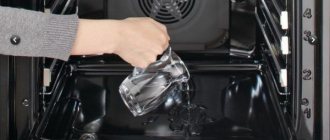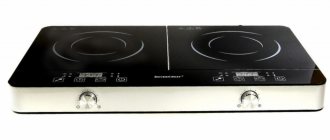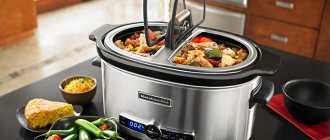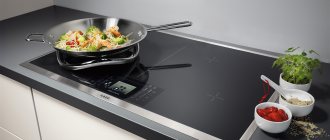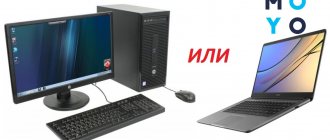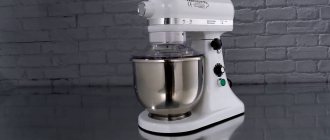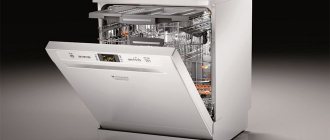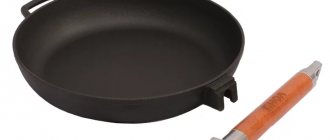Description of built-in refrigerators
Built-in units can be single-chamber devices with small parameters or full-fledged large-sized refrigeration cabinets with several chambers. The main positive aspect of this technique is the ability to integrate it into a kitchen set, thereby slightly smoothing out the rough outlines of the device. There are also models that are not fully built-in, but partially - this effect is achieved due to the sash, which is covered with a specialized decorative panel.
Reference! The partially built-in unit is located in a niche, but the sash is not masked by anything.
You shouldn’t treat a refrigerator as a piece of furniture, since the operating conditions for this type of equipment are much more difficult to meet than in the case of standard free-standing refrigeration cabinets. The built-in unit requires additional ventilation provided there is a larger layer of thermal insulation materials. The main features of built-in refrigerators are:
- Universal external design of units. The vast majority of free-standing refrigerated cabinets are painted in light colors and, when placed in the kitchen, still stand out against the background of surrounding furniture and appliances. But a built-in refrigerator provides an opportunity not to make adjustments to the overall harmony of the interior, since it is no different from other furniture - it can be decorated in the same color scheme as the countertop or cabinets.
- In the vast majority of cases, built-in refrigerators have smaller parameters compared to free-standing ones. But, at the same time, the capacity of such units does not suffer, since the internal space of the chambers is distributed ergonomically.
- Modern models of built-in refrigerators can be placed not only at home, but also in offices, bars, hotels, since their technical design allows the equipment to be used in more difficult conditions than standard household units.
However, each type of refrigeration equipment has its own disadvantages and advantages. Built-in refrigerators are good not only for their modest parameters and the ability to place them unnoticed and “painlessly” for the interior of the room.
How to choose a built-in refrigerator?
This equipment is large, complex and expensive. Modern models are endowed with certain characteristics that are important to consider when making a choice. Let's look at them in more detail:
- Dimensions
. The most important criterion, especially if the kitchen set has already been ordered. A built-in refrigerator without a freezer is compact and can be located at any level of the kitchen unit. - Number of doors
. There are two- and single-chamber models. More popular options have different doors for the refrigerator and freezer compartments. - Energy class
. It is recommended to choose a class of at least A+. - Freezer location
. It can be located both at the top and at the bottom of the equipment. the second option is considered more convenient. - Volume
. It all depends on the number of products that are supposed to be stored, which is related to the size of the family. - Defrost function
. For this technique, it is better to choose No Frost technology. - Noise level
. Even though it is in a cabinet, it is important to pay attention to the decibel number stated by the manufacturer.
Manufacturers provide modern models with additional parameters:
- adjustable humidity level;
- signaling devices;
- antibacterial coating;
- filled with numerous accessories.
Dimensions of built-in refrigerators
In most cases, a built-in refrigerator is available in certain parameters, which are matched to standard furniture:
- height - varies between 177...200 cm;
- width – 54…56 cm;
- depth - no more than 55 cm.
A small built-in refrigerator corresponds to the standard dimensions of kitchen cabinets. Often their parameters are as follows:
- height – 82 cm;
- width – 60 cm;
- depth – 55 cm.
Advantages of built-in units
Built-in devices have a lot of positive aspects. The main advantages of built-in refrigeration cabinets can be indicated as follows:
- Reduced noise levels - during operation, most of the units emit a characteristic hum. Built-in appliances have external panels in the cabinet version, which not only close the unit, but also act as an auxiliary noise suppressor.
- Cost-effective – the walls of the device have additional thermal insulation, which reduces the energy consumption of built-in refrigeration equipment in comparison with free-standing units.
- Versatility - compact parameters allow the unit to be used not only in premises for various purposes, but also in different conditions. For example, built-in refrigerators are a good option for small kitchens.
- Inconspicuous - the unit is virtually invisible against the general background of a kitchen or other room, since its external panels completely coincide with the overall interior design.
Attention! The listed advantages are the main factors that are pushing an increasing number of buyers to purchase refrigeration cabinets in this particular design.
Negative aspects of built-in technology
Built-in refrigeration equipment has not only positive aspects, but also disadvantages, which are based on positive characteristics. The main disadvantages of built-in refrigeration devices are as follows:
- Built-in units help save space, but refrigeration equipment requires allowances for ventilation. For this reason, the unit is able to take up more space than ordinary free-standing refrigerated cabinets. Much depends on the dimensions, but often it is not possible to save space and this becomes a disadvantage of built-in equipment.
- The thermal insulation of built-in refrigerators is enhanced, which reduces energy consumption, but this is not entirely true. The cooling process of the condenser and compressor requires significant energy consumption and therefore there is no actual energy saving.
- The high cost of equipment is the main negative side of built-in household appliances in general, and not just refrigerators. It is also necessary to take into account the need for some additional financial investments to install such a unit.
The listed disadvantages may seem insignificant, but their presence must be taken into account when deciding on the advisability of purchasing this type of equipment.
Disadvantages of a built-in refrigerator
Many people may think that using a built-in refrigerator will help save space in the kitchen. But this is not entirely true, because with proper installation you will need to make allowances to ensure ventilation. Due to this, it will be necessary to purchase devices with smaller chamber volumes.
At first glance, it seems that with enhanced thermal insulation there will be less energy consumption, but this is far from the case. In some models it is consumed more than in conventional ones, since a large volume is spent on cooling the condenser and compressor. At the same time, the refrigerator operates more intensively, which leads to faster failure and wear of the main components and parts.
Well, an undeniable disadvantage for the average user when buying a built-in refrigerator is not only its high cost with lower technical characteristics , but also the high costs of arranging a place for the refrigerator and its installation.
The feasibility of purchasing a built-in refrigerator
To make an informed decision about the advisability of purchasing a built-in refrigeration cabinet, you need to understand what exactly is needed from the equipment and what results are expected from the purchase of such equipment. Buying a built-in refrigerator is justified in the following situations:
- During the installation of the kitchen, there were problems with the selection of furniture. If you want to get the perfect interior, then choosing a freestanding refrigerator so that it does not stand out from the overall design is difficult. In this option, built-in refrigeration devices will be the optimal solution.
- When it was originally planned to hide the refrigerator from view and make it invisible against the general background of the interior.
- The future owner is ready to accept the fact that the capacity of the unit will be slightly less than in the case of classic free-standing units.
But, you should not purchase a built-in refrigeration unit under the following circumstances:
- When various auxiliary options play a significant role, for example, electronic control, making soda, and the like. Built-in units do not have such auxiliary functions.
- A large volume of the refrigerator is required, which is actually not feasible in built-in equipment models.
- It is the functional indicators of the unit that play an important role, and not its design and the general appearance of the kitchen space, when the “invisibility” of the unit is not really needed.
- When financial resources do not allow you to purchase such expensive equipment, which significantly impacts the family budget of the average person.
Built-in technology has not only positive aspects, but also negative aspects. In general, determining which design of refrigeration equipment is better is a personal matter for each person and one must focus only on one’s own desires and expectations.
Advantages and disadvantages
Built-in refrigerators have the following advantages:
- They harmonize with any interior, even one that does not recognize man-made elements. The same refrigerator can be used in a Provence-style kitchen with cozy curtains and ruffles, bright and outrageous pop art or baroque with a full set of cutlery and crystal. The standard model does not always fit into the interior of the kitchen.
Kitchen in Provence style (built-in refrigerator in the corner)
- They are invisible, completely hidden behind decorative panels, only the control display remains visible.
- Equipment located in wall niches or cabinets will be quieter, almost silent. This proximity to furniture and walls helps absorb sound, while the operation of an ordinary refrigerator can be heard even from another room.
- A large assortment allows for practical solutions. For example, several small low refrigerators can be placed under a regular or island countertop.
Location of the refrigerator under the countertop
- The hidden model makes the kitchen much cozier; it seems that this is not a working room for cooking, but a living room or dining room.
- As a rule, built-in appliances are equipped with the most modern, latest functions.
There are several disadvantages to equipment that is hidden in furniture. By installing it, people think that they will save space in the kitchen. This is a misconception; on the contrary, more space will be required because allowances must be left for ventilation.
It is also wrong to assume that increased thermal insulation will help save energy. Built-in appliances will not save any electricity, because large amounts of energy are required to cool the condenser and compressor. The energy consumption class is the same for both options.
When choosing, consider a number of other disadvantages of built-in models:
- they have less useful chamber volume;
- work intensively, parts and main components wear out faster, which reduces service life;
- the price is higher than regular ones;
- if you want to rearrange the kitchen, you won’t be able to move the built-in appliances;
- Additional costs are required to attract installation specialists.
A specialist installs a built-in refrigerator
Which built-in refrigeration equipment is better?
When choosing a built-in unit, it is desirable that the selected refrigerator has the following characteristics:
- energy consumption A++ class;
- availability of warranty period;
- European assembly;
- electronic control type;
- presence of a freshness zone;
- two cooling circuits and a pair of compressors;
- defrosting system full no frost or ordinary no frost;
- stainless steel coating;
- glass or metal shelves;
- separate shelves for drinks or minibar;
- antibacterial coating, child protection;
- rapid cooling and freezing;
- "Vacation" mode;
- signal sensors and indicators;
- ice maker and cold water dispenser.
The listed characteristics are desirable, but if any of the functions or capabilities are not needed in a particular case, then you should not buy a built-in refrigerator with it for economic reasons.
Operating rules for built-in units
When using the built-in refrigerator, the following rules must be observed:
- During transportation, it is important to ensure that the piping is not damaged, as the refrigerant is a potentially flammable gas.
- There should be no sparkling household appliances or open flame sources in the immediate vicinity of the unit.
- When electronics or electrics in built-in units fail due to the characteristics of these units, a repair specialist is called.
- It is prohibited to use electrical appliances inside the cells.
- Defrosting must occur independently, without speeding up the process with the help of a hair dryer, steam cleaner or sharp objects.
- It is permissible to keep strong alcoholic drinks in the refrigerator only in a tightly sealed state and in a standing position.
- To prevent porosity of the plastic or rubber seal, it must be prevented from coming into contact with oil or other fats.
- It is prohibited to store liquids in glass containers in the freezer compartment.
- Ventilation holes must remain open - air must have free access to them.
To extend the service life, you must follow all the recommendations listed in the manual.
Extending the “life” of a built-in refrigerator
Budget models of built-in refrigerators generally require manual defrosting; more expensive ones have an automated defrosting option. However, equipment of any class requires minimal maintenance. When transporting units, they must be placed vertically so that oil from the compressor does not enter the cooling circuit. When this oil is mixed with freon, the pipeline quickly becomes clogged and the equipment fails. When exclusively horizontal transportation is possible, the compressor tube must “look” upward.
After transportation, the unit is washed and allowed to dry on its own. After the moisture has completely evaporated, the refrigeration equipment is turned on without food, and food is loaded into the compartments only after the operating temperature has been reached in the chambers.
The external surfaces of the unit are cleaned as necessary using a damp cloth without detergents or soap; it is permissible to use soda. Stainless steel parts require special care as they stain. A suitable means for washing them is indicated in the instructions for the unit, and if not, you can use a universal non-aggressive and non-abrasive cleaner.
Great attention is paid to cleaning the rear wall - the main thing is not to damage the pipeline through which the refrigerant circulates. It is advisable to remove dust using a hand-held vacuum cleaner with a specialized attachment.
The moments of care for the inside of the chambers depend on the set defrosting mode. When the refrigerator does not have a No Frost system, and frost appears in the freezer on the back, cleaning takes more time. Wait until the ice build-up completely defrosts and melts, while simultaneously collecting the resulting water. Then they wipe the surfaces with a soft cloth, which is soaked in warm (20-30 °C) water with a small admixture of disinfectant. It is forbidden to scrape off ice, as this may damage the pipeline through which the refrigerant circulates.
Attention! Do not allow water to get into the lighting system or temperature controller.
When a built-in refrigerator has a No Frost system, cleaning involves wiping the shelves and walls of the chamber with a disinfectant. It is advisable to wipe the rubber seals and the evaporator only with clean water to prevent deformation of the elements.
After cleaning the outside and inside of the refrigerator, wipe it with a dry soft cloth. To prevent the occurrence of unpleasant odors between cleanings, absorbers and deodorants are used to purify the air and mask odors. For many models, the manufacturer has provided a built-in deodorant.
If the manufacturer has not provided a “Vacation” mode, then during travel it is recommended to turn off the unit, clean it, removing all products and leaving the door open for the duration of the trip. Freely circulating air will prevent the formation of mold and unpleasant odors inside the chambers.
Results
Built-in refrigerators are household appliances that can be placed in the kitchen, while “hiding” them. This technique allows you to preserve the original harmony of the interior, which can be ruined by a standard free-standing unit due to its “conflict” with the environment. But built-in refrigerators also have negative aspects, the main one of which is the high cost of such equipment. Therefore, the decision to purchase a built-in household refrigerator must be weighed, since such devices not only significantly cost money, but also require special care during operation.
When all the pros and cons of such equipment are considered and the decision is made in favor of purchasing built-in refrigeration equipment, you need to choose a specific unit according to its technical characteristics, since often the usual set of functions is insufficient. If you have decided to buy an ordinary free-standing refrigerator only for financial reasons and there are doubts about how it will fit into the interior, then you need to imagine how it will look in the kitchen and how much better the built-in unit will fit. When only built-in appliances are suitable, and a classic refrigerated cabinet does not decorate the kitchen, then it is better to buy the first option right away, since then you will always regret buying a free-standing unit that spoils the interior.
Video: installing a built-in refrigerator
I recommend to read:
- Dimensions of a built-in refrigerator - Standard dimensions of built-in refrigerators First of all, the depth of the product is standardized - this is necessary to create a smooth facade. A refrigerator built into a cabinet has…
- Top 8 best built-in refrigerators Electrolux - Electrolux is a Swedish manufacturer that specializes in the manufacture of household and professional appliances. He is responsible for washing machines, ovens, stoves, and...
- Refrigerator with inverter compressor - Home appliance stores offer customers a huge range of refrigerators. This article talks about what an inverter compressor is in a refrigerator, describes...
- Is it possible to build a regular refrigerator into a kitchen cabinet? — Built-in refrigerator is a salvation for small kitchens. It allows you to freely design the room without standing out from the general ensemble. But you can’t embed...
- TV on the refrigerator - pros and cons - Kitchens, especially in multi-storey Soviet buildings, have a small footprint, which does not allow you to distribute everything you need over the surfaces. The result is multi-story…
- Types of bacteria in the refrigerator and antibacterial coating - From this article you will learn what types of bacteria are in the refrigerator, where they come from, and how antibacterial mats, filters and wipes help combat this problem. More…
- Refrigerators and freezers from the French manufacturer Leran: review of models - The Leran refrigerator is a little-known unit on the domestic market. However, such free-standing refrigerated cabinets and freezers are purchased quite often, as they…
Types and features of built-in refrigerators
Such models differ in size, number of working chambers, doors, and types of evaporation systems. A distinctive feature of built-in devices is the different installation methods.
- In terms of size, most appliances are created taking into account the possibility of installation in ordinary kitchen furniture. Therefore, their standard dimensions do not exceed 80 cm in height and 55 cm in width. But manufacturers have provided for the possibility of installation in high columns. For such cases, models with a height of up to 200 cm are produced. The width also varies. Side-by-Side devices can extend beyond 60 cm.
- Based on the number of chambers, single-chamber and two-chamber units are distinguished. The first type of device can be designed either for freezing or cooling food. These are small devices, with a working space of several tens of liters, but there are larger options. The difference can be several hundred liters. They all fit easily under the countertop. Two-chamber analogues are multifunctional. Inside they are divided into a refrigerator compartment and a freezer.
- Multi-chamber equipment has one or two doors. In the latter case, the refrigerator and freezer compartments open independently of each other. A separate group consists of two-door units. Their doors are not placed vertically on top of each other, but horizontally. Due to this, height is saved while maintaining spaciousness.
- Built-in models are equipped with a drip defrosting system or No Frost technology. Regular defrosting from these two systems requires drip. The operation of such devices is accompanied by the accumulation of condensate and the formation of ice. The second technology does not cause such problems - the equipment itself is freed from condensation, and it is easier to care for.
- In installation, the devices can be partially or fully built-in. When partially built into the box, the sides with the top are hidden. The façade is designed in an original way and must be matched to the interior design. In the second option, another decorative panel is hung on the facade. The opening angle of the door depends on the type of fastening.
Otherwise, the built-in devices are no different from the classics.

